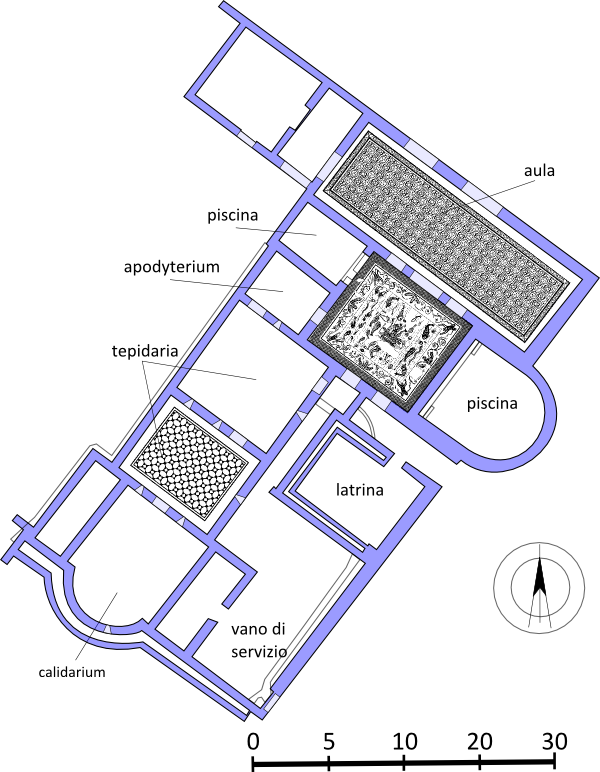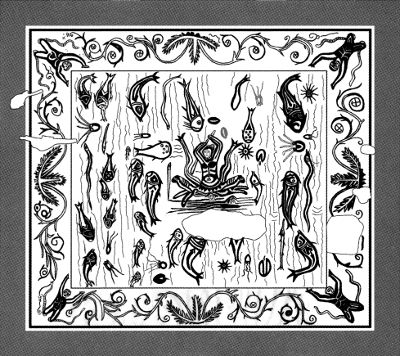The Imperial Thermaeby Francesco Tarlano, Hansjorg Thaler and Anemone Zschätzsch
The discovery story of the so-called “Imperial Thermae” of Grumentum is really interesting: in 1970 the scholar Schmiedt hypnotized, on the basis of traces visible from aerial photographs, the presence of thermal baths in the area that later was investigated by University of Innsbruck from 1999 to 2003. The archaeological data then showed as the thermal complex was built on existing structures of Republican age, obliterated during its construction. The imperial thermae were conceived from 60 B.C. and remained in use until the early third century A.C., when probably the complex was destroyed by a violent earthquake. Among Republican structures is classified a house (domus) with atrium and impluvium, within which was found a mosaic with an emblem (that is the central part, usually the most valuable of all the mosaic) rectangular in white background, with on the edge a pattern representing crenellated towers along the four sides, made with black tesserae.
The domus will be incorporated in the thermal complex in a second time. After the abandonment of thermal area, in the fifth century was realized a bakery with oven near the northern edges of the domus, while the thermal area was intended to be a necropolis in the early Middle Ages. The impressive thermal complex, one of the best preserved in the world, is of “terraced” kind, oriented to the urban road network, and has 15 rooms: the main entrance overlooked the inferior decumanus, and through a corridor it access to latrines and frigidarium, where is still preserved a wonderful mosaic with fish patterns, of Scylla and Giants.
From the frigidarium it was possible to access to east in a large mosaic room, to south in a apse room operating as swimming pool, and to north in another swimming pool smaller than the first one and to the apodyterium (changing room), which led to the first tepidarium, with a very large praefurnium, and traces of hypocausts on the sides. The paving of the large hall is decorated with a geometric mosaic, preserved for more than the half of the room, with volutes, small palms, rhombs and octagons: the comparisons, all of them localized in North Africa, date the mosaic between the second and fourth century A.C.
At the bottom was placed the apse calidarium. In the southern part of the complex there are three rooms hypothesized as service rooms for heating the complex. The water supply came from the urban water network served by the aqueduct, and the fistulae, coming from the so-called macellum aligned with the aqueduct, suggest that this structure should be a collection place for water. The main phase of the facility is dated between the Augustan and Severan period. Inside the apse pool behind the frigidarium, during the excavation has been verified an exceptional discovery: were found various fragments of statues of size slightly smaller than the human; it’s probable that in ancient times they were placed in niches inside the same room. The statues represent two nymphs, Aphrodite with a dolphin and Dionysus, they are all headless and armless, and are made using the precious Parian marble; they seem to be Hellenistic models, and that the statues should be ascribed to the school of Ephesus (a famous school of sculptors located in the Anatolian city) of the second century B.C., but the dating is still uncertain, and could swing between the second and third century B.C. The statue of Aphrodite is in pink marble, and is not part of the original group; it seems to be a Roman copy of an original Hellenistic, dated between the second and third century A.C. It seems that the statues were destroyed while they were still in this place in Late Antiquity age, to be successively abandoned within the rubble that filled the pool.
This contribution is a reworking of texts by Hansjorg Thaler and Anemone Zschätzsch by Francesco Tarlano. Copyright text and images (where there aren’t other references) by Hansjorg Thaler, Anemone Zschätzsch and Francesco Tarlano. |





 The mosaic is made with tesserae white, black, gray, dark blue, turquoise and green. The external frame is gray, with flower patterns on the edge (three-lobed acanthus leaves and tendrils spiral) and four male figures at the corners, representing Giants with snake-shaped extremities, on their knees, with arms up holding the emblem, in which are depicting numerous fishes. The water theme of the emblem is in a strong thematic connection with the thermal environment. In the middle there is Scylla, full-face, with torso naked, surrounded with a crown of fins, under which are depicted three dog busts; his arms are raised, and a hand grips a branch. The water reflections are made with wavy lines. The dating of mosaic, very uncertain, should be between the second and third century A.C.
The mosaic is made with tesserae white, black, gray, dark blue, turquoise and green. The external frame is gray, with flower patterns on the edge (three-lobed acanthus leaves and tendrils spiral) and four male figures at the corners, representing Giants with snake-shaped extremities, on their knees, with arms up holding the emblem, in which are depicting numerous fishes. The water theme of the emblem is in a strong thematic connection with the thermal environment. In the middle there is Scylla, full-face, with torso naked, surrounded with a crown of fins, under which are depicted three dog busts; his arms are raised, and a hand grips a branch. The water reflections are made with wavy lines. The dating of mosaic, very uncertain, should be between the second and third century A.C. From the first tepidarium was possible to access to another one, very well preserved, with the
From the first tepidarium was possible to access to another one, very well preserved, with the